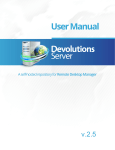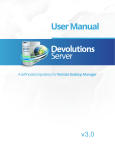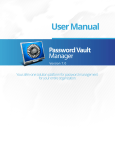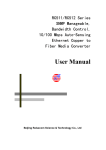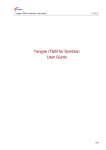Download Remote Desktop Manager Server
Transcript
Version 2.0 © 2014 Devolutions inc. Contents 3 Table of Contents Foreword Part I Getting Started 0 6 1 What is ................................................................................................................................... Remote Desktop Manager Server? 6 2 Features ................................................................................................................................... 6 3 System................................................................................................................................... Requirements 7 Part II Management 10 1 Remote ................................................................................................................................... Desktop Manager Server Console 10 2 Web Client ................................................................................................................................... 11 3 Authentication ................................................................................................................................... 14 4 Automatic ................................................................................................................................... User Account Creation 14 5 Security ................................................................................................................................... 14 Security Group .......................................................................................................................................................... Managem ent 14 User Managem .......................................................................................................................................................... ent 16 Role Managem .......................................................................................................................................................... ent 18 Part III Installation 22 1 Installing ................................................................................................................................... Remote Desktop Manager Server 22 2 Upgrade ................................................................................................................................... Remote Desktop Manager Server 30 Part IV How To 34 1 Configure ................................................................................................................................... Client Data Source 34 2 Configure ................................................................................................................................... RDMS to use integrated security 35 3 Configure ................................................................................................................................... SSL 35 Part V FAQ (Frequently Asked Questions) 42 Part VI Technical Support 44 Part VII Follow Us 46 Index 0 © 2014 Devolutions inc. 3 Getting Started Part I 6 Remote Desktop Manager Server 1 Getting Started 1.1 What is Remote Desktop Manager Server? Description Remote Desktop Manager Server is a self-hosted repository for storing and sharing remote connections, virtual machines and sensitive information. Used in combination with the Remote Desktop Manager Client, it extends its capabilities to create an Enterprise wide high-end data store. To learn more about our other products and their differences, consult this document here. Highlights High-end security server for your company Share your sessions with multiple users Can be deployed online or internally Support Windows authentication and Active Directory group integration Client and server side caching optimization Requires the Remote Desktop Manager Enterprise client 100% compatible with the SQL Server data source Remote Desktop Manager Server supports only SQL Server as a data store at this time. Editions Remote Desktop Manager Server exists in 3 editions: Small Business edition, Corporate and Unlimited. Please consult the product web site at http://remotedesktopmanagerserver.com/ for all the details. 1.2 Features Overview Features Maximum session count Database connection Descriptions Unlimited Behind server Caching Server caching Client-side caching X X Multi-user suppport X Windows authentication (Active Directory) X Group integration (Active Directory) X Security management Built-in Database user support X © 2014 Devolutions inc. Getting Started Security group Role management Per session security access (view, edit, delete) Custom database encryption with pass phrase Per user setting / credential custom values Per machine setting / credential custom values 1.3 X X X X X X Connection logs X Session document attachments: Word, Excel, PDF, Visio ... X System Requirements Minimum Requirements Windows XP (SP2 or later), 2003, Vista, 2008, 7, 8 and 2012 Microsoft .NET Framework 3.5 800MHz processor 512MB RAM 1024 x 768 screen resolution 500+ MB hard drive space .NET 4.0 does not contains the .NET Framework 3.5. You will need to install it separately. 64-bit Support Remote Desktop Manager Server is compatible with all 64-bit versions of Windows, starting with Windows Vista SP1. Dependencies Microsoft SQL Server 2008/2012 (Express edition is supported) Internet Information Services (IIS) 7.0 or better Remote Desktop Manager Enterprise installed on the server. © 2014 Devolutions inc. 7 Management Part II 10 Remote Desktop Manager Server 2 Management 2.1 Remote Desktop Manager Server Console Console 1. Because of Console manages an IIS installation, Remote Desktop Manager must be run with elevated privileges. You must use "Run as Administrator" to launch it. You can modify the shortcut to always start it in this fashion. 2. Select Tools -> Remote Desktop Manager Server Console Menu Rem ote Desktop Manager Server Console Actions New © 2014 Devolutions inc. Management 11 Modify Delete Upgrade Manage Users Manage Groups Manage Roles View web client 2.2 Web Client Remote Desktop Manager Web Client Start web client and login Web client View/Modify Sessions Because of documented vulnerabilities of web browsers, particularly their extensions, we do not perform any decryption in a web browser. The web interface is limited on purpose and you must use the client to perform any modification to a session. © 2014 Devolutions inc. 12 Remote Desktop Manager Server View /Modify sessions View/Modify Users View /Modify users View/Modify Security Groups © 2014 Devolutions inc. Management View /Modify security groups View/Modify Account View /Modify account © 2014 Devolutions inc. 13 14 2.3 Remote Desktop Manager Server Authentication Remote Desktop Manager Server supports multiple authentication modes. Authenticate with built-in user The ASP.NET membership framework is used to authenticate the user with its hashed password in the database. Authenticate with domain user The domain is used to authenticate the user. The domain authentication is the most secure, flexible and easiest to manage. No need to sync users between the domain and Remote Desktop Manager Server. On first use of the Remote Desktop Manager Server data source the user will be created and be given access rights according their role in the organization as defined on the domain. Make sure you configure appropriate rights to your domain roles in Remote Desktop Manager Server. Authenticate with local machine user The application allows a local user (on the RDMS host) to be authenticated unto the server, even through the web interface. 2.4 Automatic User Account Creation Description When using Remote Desktop Manager Server authentication, obviously the user account need to be created beforehand in order to authenticate to the system. In all other cases (Domain user, Local machine user or Database user), there is not match found in RDMS with the user which is authenticating. You can create the user beforehand and assign rights as you choose, but in the event that a user logs in while there is no account for him, RDMS will create the user account. This must be allowed in the settings of the RDMS. User accounts created by the server have no rights other then logging on the system. They will be able to see and edit the objects that have no security defined. After their first login, their account is created but you must assign them the rights you see fit. Depending on the authentication mode used, the user name may be prefixed by the domain name. 2.5 Security 2.5.1 Security Group Management Description Security Groups are used to classify sessions and restrict access to certain users. There is no direct © 2014 Devolutions inc. Management 15 relationship between Active Directory and Security Groups. By default, every session is created without a security group, and is visible to all connected users. You can give access to a group for a user or a role. Steps: 1. 2. 3. 4. Create the security groups Assign the security group to the session Create the required users Link the security group to a user Notes: All sessions without security groups are considered public. Creating Security Groups Security groups are created from the menu in File > Administration->Security Groups. Edit the data source security groups Enter a name and a description for the security group. The name must be unique © 2014 Devolutions inc. 16 Remote Desktop Manager Server Security group dialog Assigning a Security Group to a Session Security groups can be assigned to sessions using the session's property window. Each session can only have one security group assigned. Session configuration - security group 2.5.2 User Management Description With the Remote Desktop Manager Server data source, you can create users and grant them permissions. You must be administrator of the database to create users and assign rights. The user administration is available from the menu in File > Administration->Users or from the Remote Desktop Manager Console when executed locally on the server. © 2014 Devolutions inc. Management Edit the data source users Adding a User If you wish, you can create a user linked to a domain or a built-in user. Domain user are created automatically the first time they log-on. They don't have any rights except what is public. User dialog © 2014 Devolutions inc. 17 18 Remote Desktop Manager Server The integrated security is used register a domain user. Linking a Security Group to a User In the user dialog, you can check or uncheck any groups. A user with administrator rights has access to all of the configured sessions from all groups. Linking a Role to a User Roles are assigned when the user is authenticated from the Domain. 2.5.3 Role Management Description Role management is only available when the Domain authentication is enabled. This allows the server to link an Active Directory (AD) group to a role in RDMS. All the role settings are applied to the users that are member of the AD group. Edit the data source roles Roles can be edited from the Remote Desktop Manager Console locally on the server or from a remote data source by using the menu File->Administration->Roles © 2014 Devolutions inc. Management 19 Role editor dialog When adding a new role, make sure to include the domain and the exact Active Directory name separated by slash. For example: TIPS To verify all the loaded roles, inherited rights or the authentication method from the client, use the menu File->My Data Source Information © 2014 Devolutions inc. 20 Remote Desktop Manager Server Data source inform ation dialog © 2014 Devolutions inc. Installation Part III 22 Remote Desktop Manager Server 3 Installation 3.1 Installing Remote Desktop Manager Server Topology Remote Desktop Manager Server is in fact a Web application. This allows for exposing its services on the Internet or simply an Intranet. The recommended topology is to use two servers : a Database server and a Web server. Obviously, for small installations, a single server can be used, but resources will be shared between the two roles thereby lowering performance. Remote Desk top Manager Enterprise Edition must be installed on the web server in order to manage the Remote Desk top Manager Server web application. It's highly recommended to enable SSL Encryption to protect communication with the instance of SQL Server. Please follow directions on http://support.microsoft.com/kb/316898 For active directory integration, both servers need to be joined to the domain. How to install the server Web Server Pre-requisites Make sure Internet Information Services is installed with all the ASP.NET requirements. © 2014 Devolutions inc. Installation 23 Window s features Database server pre-requisites Install SQL Server Express or Standard. Download SQL Server 2012 Express from Microsoft's site Remote Desktop Manager Server has no requirements that would dictate what communication protocol is used, as well as many of the options offered to you by SQL Server. As long as the client workstation can connect to the SQL Server, Remote Desktop Manager Server will work. Also note that Microsoft has upped the default security in the 2012 version of SQL Server. The SA user is now initially disabled and you must understand each option when installing. Remote Desktop Manager 1. Download and install Remote Desktop Manager on the web server. Download 2. Execute Remote Desktop Manager with elevated privileges (run as administrator). 3. From the menu Tools > Remote Desktop Manager Server Console, open the Remote Desktop Manager Server console. © 2014 Devolutions inc. 24 Remote Desktop Manager Server All operations done through the console are done with the credentials used to launch Remote Desktop Manager Server. If you must use other credentials you must launch another window session. The RunAs command does not offer the option of starting a process with elevated privileges. 4. Deploy a new server instance. Rem ote Desktop Manager Server - Console 5. Configure the server with the name settings and authentication mode. © 2014 Devolutions inc. Installation 25 Rem ote Desktop Manager Server settings Authenticate mode Description Built-in user The RDMS is used to authenticate the user. You must create the initial user through the console Domain user The domain is used to authenticate the user. Local machine user The application allows a local user to be authenticated unto the server. Database user The database is used to authenticate the user 6. Enter a serial, alternatively you can Request a trial 7. Optionally configure the email setting © 2014 Devolutions inc. 26 Remote Desktop Manager Server SMTP Configuration page 8. Ensure the ASP.NET State service is started or set to automatically start. The State Service is require to maintain web session information between each call. Auto Start Service 9. Select a zip file or use the automatic download. Choose a destination folder and an IIS virtual directory name. © 2014 Devolutions inc. Installation 27 Source/Destination 10.Enter the database settings and create the database. You can reuse an existing database from a Remote Desktop Manager SQL Server data source and just upgrade it. It’s 100% compatible. If you wish to use integrated security to connect to the database please consult Configure RDMS to use integrated security. © 2014 Devolutions inc. 28 Remote Desktop Manager Server Create a database 11.Execute the final step and deploy the server. 12.You can test the server installation by opening the URL. e.g.: http://localhost/RDMS. 13.Configure users and security groups and add at least one administrator user account. You must create an administrator account if you've enabled the RDMS Authentication model. In other cases, the account name must match with the chosen authentication model. If you are unsure of the result, also enable RDMS authentication, create an administrator account and grant the Administration privilege to the account. After the successful authentication with the other model, the RDMS user account will have been created and you will be able to see how to format you account names. You can then disable the RDMS authentication model. Please see Automatic User Account Creation © 2014 Devolutions inc. Installation Configure users and security groups User and Security Managem ent User m anagem ent form © 2014 Devolutions inc. 29 30 Remote Desktop Manager Server 14.Configure the data source on all the client machines that run Remote Desktop Manager 3.2 Upgrade Remote Desktop Manager Server Upgrade 1. 2. 3. 4. Open the Remote Desktop Manager Server Console Select the server you want to upgrade Click the Upgrade button Select upgrade source Upgrade source 5. Next 6. Upgrade © 2014 Devolutions inc. Installation Upgrade com pleted successfully © 2014 Devolutions inc. 31 How To Part IV 34 Remote Desktop Manager Server 4 How To 4.1 Configure Client Data Source Create Remote Desktop Manager Server data source 1. 2. 3. 4. Select File -> Data Sources. New Data Source Select the Remote Desktop Manager Server data source Specify settings If you specify %USERNAME% in the user text area, the value of the corresponding system variable will be used. Data source settings Notes If the server is configured to only allow SSL, ensure you specify the protocol by using https:// in the Server field. © 2014 Devolutions inc. How To 4.2 35 Configure RDMS to use integrated security Description In order for integrated security to be used to connect to the database, you must set a domain account as the Application pool identity. Steps To make these instructions simpler, we will name the domain account DBRunner, please adapt to your requirements. , Create the DBRunner account in the domain. Grant access to the SQL Server instance to DBRunner Grant access to the database to DBRunner In IIS Manager, expand the Application pool section and locate the application pool used by your RDMS site. Normally it has the same name. In the advanced settings, edit the Identity setting to set the DBRunner account. 4.3 Configure SSL Import Certificate or Create Self-Signed Certificate 1. Select the server node in the tree view and double-click the Server Certificates feature in the list view: © 2014 Devolutions inc. 36 Remote Desktop Manager Server Server certificates 2. Click Import Certificate... in the Actions pane Or Click Create Self-Signed Certificate... in the Actions pane. Follow the w izard Create an SSL Binding 1. Select the web site in the tree view. © 2014 Devolutions inc. How To 37 Select w eb site 2. Click Bindings... in the Actions pane. This brings up the bindings editor that lets you create, edit, and delete bindings for your Web site. Click Add... to add your new SSL binding to the site. Add binding 3. Select https in the Type drop-down list. Select the self-signed certificate you created in the previous section from the SSL Certificate drop-down list and then click OK. Define https binding 4. Now you have a new SSL binding on your site. © 2014 Devolutions inc. 38 Remote Desktop Manager Server The new binding Configure SSL Settings in IIS 1. Select a RDMS application in the tree view. Select application 2. Click on SSL Settings © 2014 Devolutions inc. How To 39 SSL settings 3. Configure SSL settings if you want your site to require SSL, or to interact in a specific way with client certificates. Click the site node in the tree view to go back to the site's home page. Doubleclick the SSL Settings feature in the middle pane. Select “Require SSL” & click Apply. SSL settings Modify the Remote Desktop Manager Server configuration 1. Start any text editor (notepad) using right click Run as Administrator 2. Open the file "web.config" found in the Remote Desktop Manager Server install directory 3. locate this line in the file <add key="ForceHttps" value="false" /> 4. Modify value from false to true 5. Save the file Configure SSL Settings in RDM Client 1. Select File -> Data Sources 2. Edit the RDMS data source 3. Change the server url to start by https:// © 2014 Devolutions inc. FAQ (Frequently Asked Questions) Part V 42 5 Remote Desktop Manager Server FAQ (Frequently Asked Questions) Description You can find the most up to date FAQs online here. © 2014 Devolutions inc. Technical Support Part VI 44 6 Remote Desktop Manager Server Technical Support Contact Us Holders of a valid license obtain our Extended Support plan for Remote Desktop Manager Server. Please email any questions or suggestions to [email protected]. We also offer Premium support for an additional price. You also encouraged to find information and ask questions in our forums at http://forum.devolutions.net/. They contain years of relevant information and have the benefit or being enriched for the whole community when we post an answer. © 2014 Devolutions inc. Follow Us Part VII 46 7 Remote Desktop Manager Server Follow Us Overview Get the hottest information about our products - tips and tricks, case studies and new release announcements! This is not a marketing newsletter. We focus on the issues that matter to you, whether you're looking for up-to-the-minute software tutorials, additional outside resources, or a peek at how others are using our products. Links Facebook http://facebook.remotedesktopmanager.com LinkedIn http://linkedin.remotedesktopmanager.com RSS feeds http://rss.remotedesktopmanager.com Twitter http://twitter.remotedesktopmanager.com YouTube http://youtube.remotedesktopmanager.com Blog http://blog.remotedesktopmanager.com Google+ http://plus.remotedesktopmanager.com/ © 2014 Devolutions inc.














































